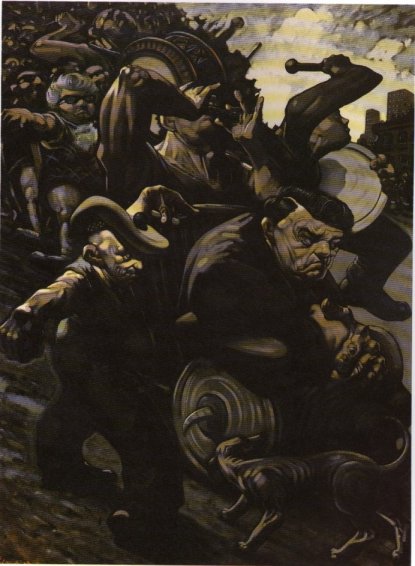

Blind Leading the Blind III, 1991. This picture depicts an Orange
Walk parade, a sight of significance to those of us who have been raised
in the West of Scotland; the grim faces and senseless fanaticism. In a
lot of Howson's work there is an underlying feeling of man's inhumanity
to man, the need to acknowledge the mindless violence and spectre of fascism
that seems to fester in modern society. Violence is endemic below the surface
of both man and the masses, these are real figures and realities. All religions
benefit by encouraging bigotry and distrust between different peoples,
which has the effect of binding their followers more closely to the Church
(remember for example, that the Catholic Church is a massive, very rich
multinational company, but the vast majority of Catholics in the world
are peasants living in squalid conditions, yet they are expected to give
and live for the greater glory of God whose spokesman on Earth is the Pope,
a supporter of some of the most Right-wing regimes in the world and someone
who violently opposes abortion and contraception, condemning many woman
to poverty and patriarchy). It is deeply ironic that although the Protestant
Orange Order consider themselves to be British, they are viewed as an Irish
problem by the mainland UK government and are subject therefore to all
the usual racism and bigotry when they come to Britain.
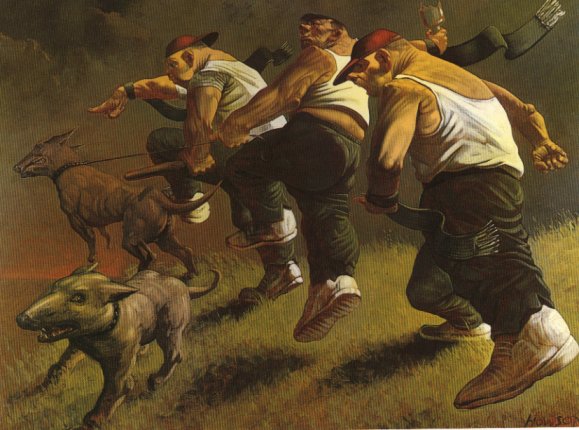
Patriots, 1991. The "Patriots" theme is one of Howson's most enduring, he has always felt very strongly about fascists, neo-Nazis, racists and bullies of any kind. This picture demonstrates the disgusting, powerful and violent hatred of thugs and their equally as repugnant dogs. The title is highly ironic. The aggressive, clench-fisted and piggish figures are blind ignorant fascists. Fascism is extremely dangerous as it can be used by "The State" to promote a national identity, where the majority working classes are bound closer to the ruling classes then to each other, which leads to racism, religious bigotry and sexism
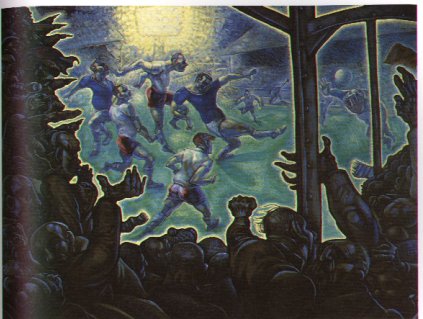
Just Another Bloody Saturday, 1987. Howson has made many studies associated with football violence, in this work there is a football match in progress, but the crowd are indifferent to what is happening on the pitch; a neo-Nazi mob is creating mayhem in the crowd, all fascist salutes and twisted faces. The mob is indeed the tool of fascism, Howson says " the mob is a very pliable thing, it's like Plasticine, and it's an ugly, horrible thing. Any ordinary person on the street can be involved in the mob....can become fascist...a bank manager, a stockbroker, a schoolteacher...." The floodlight should be a source of hope and one is naturally drawn to it, but it could be an evil eye, casting its gaze over the distorted forms in the crowd, highlighting all with an eerie glow.
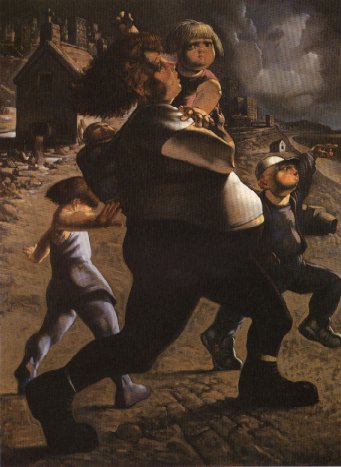
Blind Leading the Blind I , 1991. The social and genetic perpetuation of the underclass. The ugly landscape and lead-grey skies of the Ayrshire coastline, a bloated mother, her sullen and malevolent children, running towards the sea. Drabness is combined with menace. Derelict houses and the pervasive feeling of nothing to live for, except the future vices and brutalities of the womans son, clearly a young "Patriot". Traditional images of Scotland have often sentimentalised deprivation and poverty, especially in cities where the most stark and brutal examples of the misery of poor housing and harsh living conditions are widespread.
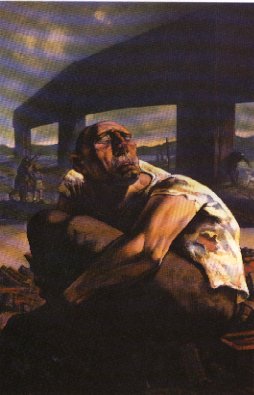
The Bridge to Nowhere, 1991. The atmosphere of despair and hopelessness of life is depicted with great effect in this painting. The crouched figure of the "dosser" (a Glaswegian term for someone who lives on the streets), with his ripped shirt and weathered face, are a common sight on many on Britain streets. The bridge ends suddenly after the last of the three visible pillars, indeed there is "nothing to look forward to on the horizon" in this work. The dosser's clear blue eyes have a blunt, clear grasp of the ultimate ugliness of urban life. The vices of Scotland and in particular excessive alcohol consumption are often described as a way to escape into oblivion
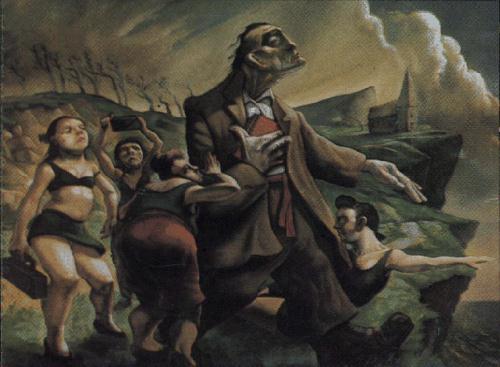
Sisters of Mercy, 1989. The subjects of betrayal, revenge and
fear are exemplified in this work. The man, holding a Bible close to his
chest, is being urged to throw himself over the cliff by a group of prostitutes.
His eyes are closed, his faith in God seemingly undiminished as he nears
death. Could this suggest the futility of religion? Here the beauty and
majesty of the windswept coastline, the antithesis of the harsh city environment
of the prostitute, is contrasted with the ugliness and brutality of humanity
against humanity. The victim is a symbol of both heroic strength and blind
faith. The prostitutes can reflect on the fact that although their victim
will die, they will be trapped in a society where others will determine
their fate.